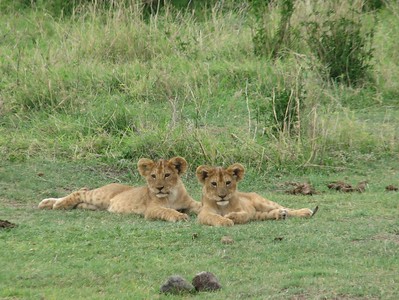Ngorongoro

The Ngorongoro Conservation Area is centered around the Ngorongoro Crater and the hominid fossils found in the Olduvai Gorge.
The crater floor is the world's largest unbroken, unflooded volcanic caldera. Its grassy plains with both fresh and brackish water lakes provide a natural enclosure for a very wide variety of wildlife. Ngorongoro is also part of the annual Serengeti migration route of wildebeest and other ungulates. With Laetoli, where fossilized footprints have been found, and remains of a number of diverse hominin species within the Olduvai Gorge, the site also has contributed to the study of human evolution.
Community Perspective: This covers a large area that extends well beyond the crater into the Lake Ndutu area and Olduvai Gorge; their features are well-described by Squiffy.


Map of Ngorongoro
Community Reviews
Squiffy

The giraffes stared down at us. We stared up at them. Animals that had seemed gentle and almost comic from a vehicle were much more imposing when viewed from on foot. One became agitated by our presence so we retreated back to the cover of the trees lining the gorge. “Take care”, urged Taletien, suggesting we grasp the tough sisal leaves – oldupai in Maasai – as support ropes while we descended the riverbank. But as I jumped the last foot down to the fine black sand I caught the edge of my palm on a leaf tip. Blood welled up. Taletien inspected the prick: “Let me show you some Maasai medicine”. With his knife he chopped down an oldupai leaf. He twisted it so that its greenish soapy-smelling liquid dripped onto the cut. This, he explained, was a local (in both senses of the word) anaesthetic. But he still recommended a wash and a plaster once we left the gorge.
The gorge in question was, of course, Olduvai (or Oldupai) Gorge, one of the most famous paleoarchaeological sites in the world. Unlike Louis and Mary Leakey we were not searching for the remains of Pleistocene hominids; we were merely taking a breather between the two big finales of our safari, the Serengeti and Ngorongoro Crater. But we were already in the World Heritage Site: the Ngorongoro Conservation Area extends far beyond the crater itself. In the north-west it abuts the Serengeti National Park itself, then stretches south to Lake Eyasi. The Olduvai Gorge runs east-west between Lake Ndutu and the Crater. And further craters – Olmot and Embagai – can be found north of Ngorongoro. The Conservation Area is pretty big. We had planned to explore more of it; hikes up Mount Makarot or down into Embagai Crater had been discussed and discarded. But we did see three separate elements:
- The short-grass plains around Lake Ndutu, a complementary extension of the Serengeti ecosystem, thick with herbivores (and their predators). A jaunt down to the lake prior to entering the National Park revealed untold numbers of hinnying zebras, bouncing Thompson’s gazelles and plodding wildebeest, complete with fuzzy, wobbly-legged young. All the apex predators we saw (lions and a solitary cheetah) could afford to doze in the shade, so abundant was their food supply.
- The Olduvai Gorge area, interacting with the Maasai communities that live there. We visited one of the local villages to meet the tribespeople (an experience that we found rather exploitative – of us, rather than the Maasai)
- Ngorongoro crater itself. This truly is a Lost World experience, a clearly defined caldera within which nature roams wild. Entrance and exit are via roads built into vertiginous slopes. Inside, most of the animals we had grown to know and love over the previous week were present and correct: zebra, gazelles and wildebeest; elephants and hippos; lions and hyenas; baboons in the Lerai forest. The crater is also the prime location for spotting black rhino in northern Tanzania (there are some in the Serengeti, but scattered across the more remote northern parts). The black rhinos at Ngorongoro are resident year round and our guide made it his priority to find them for us.
So what makes Ngorongoro different to the Serengeti? Well, both of them are inscribed on Criteria vii (with reference to the great migration) and x (with reference to the density of wildlife). But Ngorongoro is also listed under Criteria viii (with reference to the world’s largest unsubmerged caldera), ix (with reference to the variety of habitats in the NCA) and – since 2010 – iv (with reference to the “exceptionally long sequence of crucial evidence related to human evolution” – though the Unesco website does note that “the interpretation of many of the assemblages of Olduvai Gorge is still debatable”!). So the real differences in the eyes of Unesco are the remarkable caldera landforms and paleoarchaeological aspect.
I would argue that one other prime difference is that the Conservation Area is still inhabited. Residents have not been relocated to make way for a National Park. It’s a difficult balancing act. Returning from the Serengeti it was a shock to see such evidence of human activity: a gleaming mass of animal life revealed itself to be a herd of cattle, women toted water along the road, thorny-walled bomas were dotted hither and yon across the landscape. Conflict between man and animal is, perhaps, inevitable but for now coexistence seems to be holding.
World Heritage-iness: 3.5
My Experience: 4
(Visited Feb 2015)
Els Slots

Ngoro Ngoro is the sound cowbells make. At least this is one of the possible origins of the name Ngorongoro. These bells you hear right away when descending the 600 meters from the crater rim. Some Maasai herdsmen are leading their herds down for water. These herds consist of dozens if not hundreds of cows.
On the crater floor, we encounter only birds at first, such as cranes and the sacred ibis. The major salt lake also holds numerous flamingos. Unfortunately, you cannot come close, but a pink glow can be seen. Not far away is a mud bath full of hippos. These are more lively than the ones we saw in the Serengeti. They perform a full circle of 360 degrees with their fat bodies, so they get completely covered by the mud.
On a plain, our driver suddenly spots a rhinoceros. There are only 22 of them in the crater, so it's a rare appearance. He is moving among a group of wildebeest and buffaloes. With this (black) rhino, we have completed seeing the "Big Five" of predators in two days (lion, elephant, buffalo, leopard, rhinoceros).
Another highlight comes from a family of hyena just along the road. We first see a male and a pregnant female hurrying in front of our jeep. A little further it shows that they were on their way to their little ones, which are half-hidden in a pit. There are three kids in all. The whole family then huddles together nicely in the pit which is full of mud. A few meters away a large warthog is buried in the same way.
After lunch, we drive through a part of the 260 square kilometers large crater which seems to hold fewer animals. On the crater wall, there are huge herds of wildebeest, just like ants when seen from a distance. Also, there are zebras, as they are everywhere.
In a corner of the crater floor is a spot with higher grass and trees. Here we see lions again. Six of them stretched out in the grass. And then four females with two children. The latter are close to the road and look at the visitors in the jeeps. Their mothers, however, all look the other way: they have their eyes on two zebras. One lioness slowly creeps through the high grass. Two others remain on the lookout. The fourth has started a large move to the zebras from the other side to surprise them. We continue to look for a long time, but it doesn't come to an attack. Lions need to be very close to their prey to be successful, they then jump on top of it by surprise.
Brandon Davis
I recently visited Tanzania on safari for my honeymoon. We visited in early July and spent almost two weeks there. On our travels we visited the Ngorongoro Conservation Area. It was amazing. Although we were there during the dry season and everything wasn't as lush as in pictures I had seen, it was beautiful. The weather was cool to cold along the rim, but inside the crater it was perfect weather for safari. Because of it being the dry season the tsetse flies were minimal and mosquitos were not a problem. We saw lions, hyenas, black-backed and common jackals, elephants, DeFassa's waterbuck, vervet monkeys, baboons, plenty of hippos, wildebeast, zebra, Thomson and Grant gazelle, flamingo, three species of eagles, various water birds, buffalo, and four black rhino. Amazing!! A lifetime experience for naturalists. A nice note is that the crater closes at 6 pm daily and this is strictly enforced. Park rangers watch your every move from above. The needs of the animals are definitely the priority here.
Joan McNaughton
Returned to Canada from a great tour. Enjoyed our time at the crater very much. Had excellent guides/drivers with Leopard Tours, stayed at Serena Lodges and enjoyed them all very much. The Serenena Lodge at the Crater being one of my favourite. Food excellent, staff wonderful. Room very comfortable, enjoyed the cooler evening for sleeping. Saw an amazing rainbow late afternoon over the crater out my door - great photo. Saw lions, rhino, huge elephant lots of other animals also. Would have liked to see more rhino, but at least saw the one. Great day, would like to explore area surrounding crater more - next time! Enjoyed seeing the Maasai with their herds, missed them when we got to the Serengeti. Was not overly impressed with Olduvi Gorge, but it was OK.
Community Rating
- : Joyce van Soest Szucs Tamas Stephen S. Kamin Jeanne OGrady Dirk-pieter Zoë Sheng Malgorzata Kopczynska Andrea Szabo Shandos Cleaver Thomas Kunz PabloNorte Sutul Little Lauren Travels Michael Wojcik Keith90245 Christoph Travelure Deffra Sbshipway Dolemite92 JR's HERITAGE SITES Chapnis JJ10 Csaba Nováczky Javier ZCTLife Bropyk Mstrebl1990
- : Els Slots Randi Thomsen Svein Elias Sachin Joel on the Road Voyager Lucio Gorla Zizmondka Randy Aliwarga, MD Philipp Leu Priyaranjan Mohapatra Lukemarshall GerhardM
- : Solivagant Mikko Eric PK Wojciech Fedoruk Squiffy Jarrod_Byham Jon Opol Sturuss
- : Eric Lurio
- : HE SHAOMIN
Site Info
- Full Name
- Ngorongoro Conservation Area
- Unesco ID
- 39
- Country
- Tanzania
- Inscribed
- 1979
- Type
- Mixed
- Criteria
-
7 8 9 10
- Categories
- Paleontology - Human evolution Wildlife habitat - Fauna
- Link
- By ID
Site History
2010 Extended
Extension to add cultural criteria: "because of the extraordinary record of human evolution at the site" (including FTWHS Laetoli Site)
1989 Removed from Danger list
1984 In Danger
Management shortcomings
1979 Inscribed
Site Links
Unesco Website
Official Website
In the News
Connections
The site has 45 connections
Ecology
Geography
History
Human Activity
Individual People
Literature and Film
Timeline
Trivia
Visiting conditions
WHS on Other Lists
World Heritage Process
Visitors
210 Community Members have visited.
The Plaque
No plaque has been identified yet for this site.